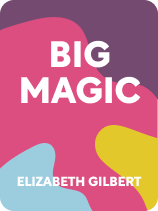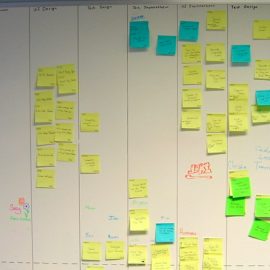

This article is an excerpt from the Shortform book guide to "Big Magic" by Elizabeth Gilbert. Shortform has the world's best summaries and analyses of books you should be reading.
Like this article? Sign up for a free trial here .
Do you often get stuck in your creative process? How do artists deal with creative blocks?
According to Elizabeth Gilbert, the author of Big Magic, if your creative process doesn’t flow, you may be fearful of the uncertainty that is inherent in creating something innovative or novel. Or perhaps, you are creating for the wrong reason (e.g. strictly to make money).
In this article, we’ll discuss Gilbert’s tips for overcoming creative blocks.
1. Accept Your Fear
The first step to overcoming your creative blocks is to find a way to manage your fear. Fear is omnipresent when we are trying to be creative. This is because fear’s main purpose is to protect us in situations of uncertainty, and, unfortunately, the creative process is full of uncertainty.
(Shortform note: There is a specific condition called “fear of the unknown,” or FOTU, which seems to be the type of fear Gilbert talks about here. The anxiety generated by fear of the unknown may be the scientific explanation for why we pull away from creative projects: When we’re burdened by worry about how a project might turn out, the easiest choice is often just to drop the project. FOTU may underpin all human anxiety and neuroticism—mental events that can make it impossible to simply function in daily life.)
However, fear is not useful in the creative realm, writes Gilbert. Despite this, she doesn’t advocate ridding yourself of fear entirely. Fear, and its function of keeping us safe in uncertain circumstances, is essential to our daily survival and well-being.
To deal gracefully with fear, Gilbert suggests you take the following steps:
- Acknowledge that fear is an inherent part of the creative process. Your brain is not wired to allow you to be creative without being fearful.
- Make space alongside your creativity for your fear, so that they can comfortably coexist. Treat fear as a friend.
- Don’t allow yourself to make any decisions based on fear. While fear may be present, it should never be the driving force for anything you do on your creative journey. Allow your courage to drive your decision-making, while fear just watches.
2. Focus Only on the Journey
As you approach a project, Gilbert also stresses that your enjoyment of the creative journey should be your only focus. Let go of any goals or desired outcomes and prioritize the process.
According to Gilbert, if you create to receive external validation or to achieve something particular, you make your creativity contingent upon forces outside of your control. You’re much more likely to give up your pursuit, then, if you don’t achieve your goals.
Don’t Strive for Success
Gilbert advises specifically against striving for some perceived form of “success.” You ultimately have little control over your creative success, so to avoid anguish and unhappiness, don’t even aim for it.
Success, in whatever shape is common to your particular creative field, is hard to come by because it’s not dependent merely upon your hard work, argues Gilbert. Often, there are creative gatekeepers to success, like publishing companies and funding agencies, which have their own agendas. Plus, success is often simply a matter of being in the right place at the right time.
3. Don’t Be Creative to Earn Money
Gilbert also advises against being creative to earn a living. Practically speaking, she says, creative work can rarely pay the bills. Relying on your creative pursuits to keep you afloat may leave you in dire financial straits, which may force you to give up your creative work altogether.
(Shortform note: The (incorrect, according to Gilbert) belief that our creativity should support us financially has only come about relatively recently. For most of history, creators—especially artists—had jobs that had nothing to do with their creative work. Some held jobs that were entirely unrelated to their creative work (like repair jobs), some used creative skills for commercial purposes (a writer might have worked for an advertising agency), and others still worked in fields that they could mine for their creative work (like working for the NYC subway). There is thus a historical precedent for creators supporting themselves other than through their creative work.)
Instead of expecting a payoff, Gilbert says that if you derive all your joy from the process of creativity, you’ll be able to stick with your creative work indefinitely. Gilbert suggests framing your creativity as a “vocation,” something you do simply because you want to. This helps rationalize your decision to stick with an activity that may have no external reward.
(Shortform note: According to Gilbert, you should focus on enjoying your creative process as a vocation: something that won’t necessarily earn you money. But not everyone has the time and energy to have a vocation. Most Americans work 44 hours per week and more and more people are holding multiple jobs to get by. It may not be realistic for these people to dedicate time each week to a creative pursuit for no reason other than to bring them joy.)
4. Strengthen Your Conviction in Your Right to Create
As you start your creative journey, Gilbert stresses the need to bolster your belief that you’re allowed to create. Your claiming this right to create is not a privilege or form of self-centeredness, says Gilbert. It is, in fact, the opposite: a way to stop thinking about yourself as being different or special or more or less gifted than anyone else. You’re just like everyone else in that we all have the right to use our minds to make things.
| Cancel Culture and the Right to Create Gilbert’s assertion of our inherent right to create seems to bump up against cancel culture. This is a recent phenomenon in which celebrities and prominent creators who have behaved or spoken inappropriately or offensively are called out, and efforts are made to shut down their creative projects. The bedrock belief of cancel culture is that creativity is a privilege, not a right. Therefore by behaving badly, a creator can have their creative privilege taken away. Louis C.K. and J.K. Rowling are examples of prominent “canceled” celebrities. The effectiveness and fairness of cancel culture are hotly contested. It’s seen negatively as fostering an unsafe environment for creators to put their work into and positively as holding those whose status previously elevated them beyond public scrutiny accountable for their actions. No matter how you see it, cancel culture is likely forcing creators to think deeply about how and when they share their work. |
Proclaim Your Right Out Loud
One specific way Gilbert suggests you own your right to create is to verbalize your creative identity. Say out loud how you’ll exercise your creative right: “I am a writer,” “I am a sound designer,” “I am a scuba diver.” Make this proclamation time and time again to remind yourself and the world of your determination to inhabit your creativity.
(Shortform note: There is science to back up Gilbert’s claim that repeatedly verbalizing your right to create helps you to exercise that right. Positive affirmations—phrases that counter negative or unhelpful thoughts—activate areas of the brain associated with positive self-perception. Constantly saying that you are a creator, therefore, helps your brain determine that you really are one.)
5. Don’t Lean on an “Official” Education
Gilbert warns against seeing your ability to create as contingent upon an externally-conferred degree or title. You don’t need an education in your creative field to legitimize your right to create.
Gilbert is particularly wary of Master of Fine Arts degrees. These are typically expensive and don’t guarantee gainful employment after. Many students emerge in debt, and debt is a stressor that saps creativity.
| The MFA Debate The usefulness of MFAs is hotly contested. Like Gilbert, many writers—both those who have MFAs and those who don’t—take passionate stances on these degrees. Detractors argue that when an MFA becomes an expectation within the publishing industry, talented writers without advanced degrees are pushed to the side, likely to never be published. Additionally, the high cost of such programs prohibits many from applying, meaning the work written in MFAs tends to reflect white, upper- and middle-class voices. Conversely, you could argue that MFAs offer learning opportunities and connections to other creators and industry figures. They are therefore valuable in that they help writers hone their skills and increase their employability. The main takeaway from this debate may simply be that despite Gilbert’s warning to stay away from these degrees, every writer should decide for themselves whether or not to seek out an MFA. |
Rather than relying on an externally conferred degree to “turn you into” a creative, Gilbert suggests you build your own education using the following approaches:
Approach 1: Study Your Own Life
If you’ve lived at all, then your life can be your education, says Gilbert. No matter your age, you’ve gained a unique perspective and collection of life experiences that can be mined creatively. Thus, rather than relying on an institution to give you resources—such as reading, lectures, and data—from which to create, plumb the depths of your life experience.
(Shortform note: Memoir-writing has become an increasingly popular way to use one’s own experience to be creative, as Gilbert suggests. People from all walks of life use the format to recount their life experiences, and readers seem to love reading the results. For instance, Christie Watson’s memoir, The Language of Kindness: A Nurse’s Story, which is based on the diaries she kept during her 20 years of work as a nurse, sold over 100,000 copies in mere weeks.)
Approach 2: Find Your Own Teachers
Gilbert stresses that you don’t have to pay for an expensive degree to gain access to master teachers. There are masters all around you: in books, on the internet, in the media, and in exhibits and presentations at public institutions. You just need to look for them and then take it upon yourself to practice what you learn from them.
(Shortform note: Gilbert proposes that you can gain just as much by studying the works of masters as by studying alongside teachers or experts. But this discounts the personalized nature of study with another human. Mentors can add value to your creative journey by conveying information and knowledge, stimulating your professional and personal growth, and offering encouragement when you need it.)
Approach 3: Start Your Own School
If you know other creatives with the same interest as you, start a “class”—a group—of your own, says Gilbert. You can collectively experience and provide feedback on each other’s work and act as a support system to one another, filling the basic functions of a school peer group. Most importantly for Gilbert, as you should do at a formal school, practice your craft. Do the creative work you want to do, and learn from mistakes and successes.
(Shortform note: A workshopping group, like the kind Gilbert describes, can do much more than get your work in front of fresh eyes: It can also help you maintain your creative flow and mental health. These groups can reduce feelings of isolation, doubts around your work, and the emotional turbulence of creative living. More generally, support groups, formal or informal, are critical to human wellbeing. Social support is linked to a decreased risk of mortality and morbidity. So, it might be worth making contact with a support group a top priority of your creative practice and life.)

———End of Preview———
Like what you just read? Read the rest of the world's best book summary and analysis of Elizabeth Gilbert's "Big Magic" at Shortform .
Here's what you'll find in our full Big Magic summary :
- Why integrating creativity into your daily life will make you feel more fulfilled
- Why creating for money is a form of self-sabotage
- Why you should never focus on external validation of your creations






